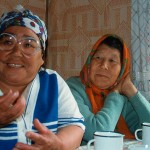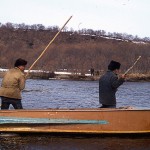
Some 250 years ago, the Itelmen language spoken on the Kamchatka Peninsula in the Russian far east was in decline and was expected to survive no more than a generation. It proved more tenacious than predicted, but it is now on the verge of extinction.
Jonathan Bobaljik, professor of linguistics, has spent a decade and a half studying Itelmen. This academic year, thanks to a Humanities Institute fellowship, he hopes to develop a grammatical description of the language and explore related theoretical issues.
“The general philosophy of generative linguistics,” says Bobaljik, “is that there are certain limitations on how languages work. There’s a common core to human language, and there’s variation. One way to find out what the limits are on variation is to examine ‘exotic’ languages, looking for patterns of similarity and difference.”
Itelmen, he adds, is well suited to such study because it is related to almost no other language.
“Even in the remotest corners of the globe,” says Bobaljik, “where languages seem at first blush very different from known languages such as European languages or Japanese, core patterns of human language and grammar are there when you know how to look for them.”
A Remote Population
Bobaljik first became involved with Itelmen in 1993, while still a graduate student at MIT. Putting his Ph.D. temporarily on hold, he joined an anthropological expedition to the remote Kamchatka Peninsula.
The peninsula is accessible only by plane, boat, or dogsled; there are no roads or trains. Officially part of Russia, it was closed to outsiders until 1990. Bobaljik and the anthropologist he accompanied were the first foreigners many of the local people had met.
The Itelmen people traditionally engage mostly in subsistence hunting and fishing. After several centuries of assimilation, their daily language is now Russian, and the number of Itelmen-speakers has dwindled to just 30, the youngest being in his mid-60s.
Those who speak the language are dispersed in different villages, rarely getting together, and phone communication is sporadic, Bobaljik says.
The researchers spent a year in the field recording the language for further study. They brought the native speakers together for weekly tea gatherings, and taped and transcribed narratives and traditional stories as well as the people’s answers to specific questions about the language.



Language and Politics
Bobaljik says the survival of a particular language is not related to its intrinsic characteristics.
“Whether or not a language survives has nothing to do with language, and everything to do with politics and economy,” he says.
Under the Soviets, Russian became the primary language and the Itelmen language was repressed for 50 years.
“It almost directly parallels what happened to indigenous communities in the U.S.,” says Bobaljik. “There was forced assimilation. Children were beaten for speaking their native language.”
Only in the 1980s, did it begin to be legitimate to embrace the native culture, he adds.
Bobaljik says Itelmen history offers broader lessons for endangered languages.
“When you look carefully at both the decline and the surprising tenacity of Itelmen, you can begin to discern some factors that work in both directions,” he says. “The fate of the language is almost exclusively about politics, but it also partly, in communities this small, comes down to particular individuals and their views.”
Traditionally, the Itelmen lived in tiny, scattered settlements, but the Soviet government created larger communities. In two villages, the language died out almost immediately after collectivization; in another two, it survived much longer.
The difference was the village teachers, Bobaljik says.
Although the language of instruction in all the villages was Russian, if the school teacher spoke Itelmen outside the classroom, the language persisted – an illustration, he says, of how “in a small community, the culture can be shaped by the values of an individual who has prestige.”
Preserving the Language
There is currently some local interest in preserving the language, and it is still taught in schools to a handful of children. But Bobaljik says most people are struggling to survive economically, and for them, the indigenous language is not a priority.
The ability to speak Itelmen carries implications for both political and cultural identity. Indigenous people – identified primarily by language – have certain legal rights not accorded to other residents. Some in the government, says Bobaljik, would prefer to believe the indigenous community no longer exists and do away with those rights.
He predicts that fragments of the language will persist in ceremonial contexts, fostered by the growth of ethnotourism.
This fall, Bobaljik will immerse himself in the study of Itelmen, working with more than a hundred hours of audio recordings he made in the 1990s with collaborator Susanne Wurmbrand, who is also now at UConn. It’s painstaking work that requires listening to particular segments over and over.
He wants to make his work available to the Itelmen people. He has already sent copies of some of the texts he recorded, and helped produce educational materials in collaboration with two teachers there. Without museums, he says, “schools are the closest thing to a repository.”
Electronic materials are not practical, however, since some of the villages don’t have electricity. “What are you going to do?” he says. “Send a CD-ROM?”


